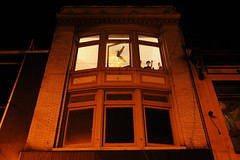Keep reading for an unboxing video, an installation video and a torture test from our meetup.
__________
Zeke, over at nicephotomag.com, was so excited to get his P1's he fired up the video camera for the unboxing. He posted this on his site:
There is a little bit of a learning curve to installation and use of the P1s. It's not rocket science, but it is a little more involved than slapping on a pair of Pocket Wizards. Jared Platt has created an installation video, which has been posted to the RadioPopper site. You can watch in a separate window here.
__________
But How Well Do They Work?
I got to play with them for about an hour Friday night in a studio in Baltimore, where a bunch of locals were having a Strobist lighting meetup. Don "Wizwow" Giannatti was on hand, in advance of his East Coast lighting seminar.
The bottom line for the RadioPoppers: In a normal, large-room working environment, I could not get them to fail.
Full length of the 60-foot room? Fine.
No line of sight? No problem.
Firing with a TTL flash in an adjacent room for a little accent? Every time.
Once you get the hang of using them, it is basically just like using eTTL, or iTTL/CLS. But you no longer have the 33-feet, line-of-sight, 30-degree angle limitations. As with out in Phoenix, we tried some hi-speed FP sync stuff, too. Worked like a charm.
 In fact, I had to leave the building to drive them to failure. Actually, to me more accurate, they were intermittent in this situation.
In fact, I had to leave the building to drive them to failure. Actually, to me more accurate, they were intermittent in this situation. In the photo above, I had two SB-800s bouncing off of the third-floor studio walls in TTL mode with RPs. Firing my D300 three floors down from the middle of the Light Rail tracks on Howard Street at night, (which is just so stupid on so many levels) I got about a 50% firing rate. But the studio building is an old, brick. typical inner-city structure. This was a bit of a torture test, and pushed the limits of what they could do.
In normal working situations -- outside shooting, large interior room situations, etc. -- they perform very well. I think many people are really going to be stretching what they can do with wireless TTL.
One downside I note is that you have to remove and replace two screws to change the (AA) battery. This will be a bit of a pain for some, I'd think. But I am told the things sip juice pretty economically, so this will not be something you'd be doing halfway through a wedding.
The screws are metal-into-plastic. So use a little care and do not go Incredible Hulk on them so as not to strip the threads. This, BTW, was because the cases were off-the-shelf, which got around the need for the very expensive design molds that can add six digits and much time to the prototyping and production models.
One other thing you'll have to learn as a result of the RadioPoppers that has nothing to do with the RPs themselves. When shooting TTL from a great distance, you may have to dial down the light on your subject if it is a very small part of the compositional frame. This is a limitation of the TTL metering of the cameras themselves, and each system will behave a little differently. But I found it was very easy to dial in the right amount of flash from the shooting position via the CLS system on my D300.
I am not the only person out there playing with the RPs. Matt "Who Needs Instruction Manuals" Adcock jumped right in with them at a wedding shoot. Also, San Francisco-based photog Ed Pignol is playing with them here.
As you guys know, I am not much of a wireless TTL guy. But you CLS'ers and eTTL'ers will hanceforth have lots more capability built into your flash systems with the RPs. Congrats to Kevin King for all of the technical and economic hurdles he bested in getting a very complicated and sophisticated product to market.
_________
Read more:
:: RadioPopper.com ::
:: Brand New (Official) RadioPopper Flickr Group ::




0 comments:
Post a Comment